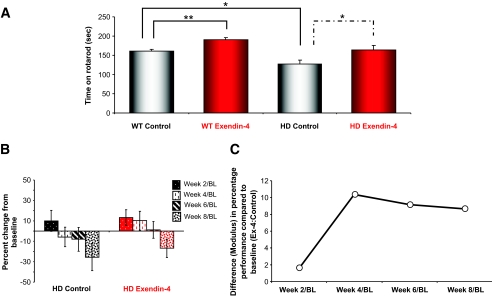FIG. 5.
Ex-4 treatment improves motor coordination in Huntington's disease mice. Motor performance was measured bi-weekly using an accelerating rotarod apparatus. Mice were placed on the rotarod, which accelerated from 4 to 40 rpm over a 5-min test period, and latency to fall was recorded. A: Average time spent on the rotarod during the course of treatment for each study group is shown. Treatment with Ex-4 significantly increased the rotarod times of Huntington's disease mice (P < 0.05). Ex-4 treatment also increased the rotarod latencies of wild-type mice (P < 0.01). B: Analysis of percent change in rotarod performance from baseline confirmed that the performance of the Ex-4–treated Huntington's disease mice showed a much slower rate of motor control decline than the saline-treated Huntington's disease mice. Hence, at each time trial, Ex-4–treated animals showed a greater time on the rotarod compared with saline-treated animals. C: The relative week-to-week differences (modulus) in rotarod performance (percent change from baseline) between Ex-4–and control-treated Huntington's disease animals expressed as a ratio. Hence, an increase in the ratio denotes a relative increase in maintenance of rotarod performance in the Ex-4–treated animals compared with control. Values are means ± SE, n = 19–24 animals per group.

